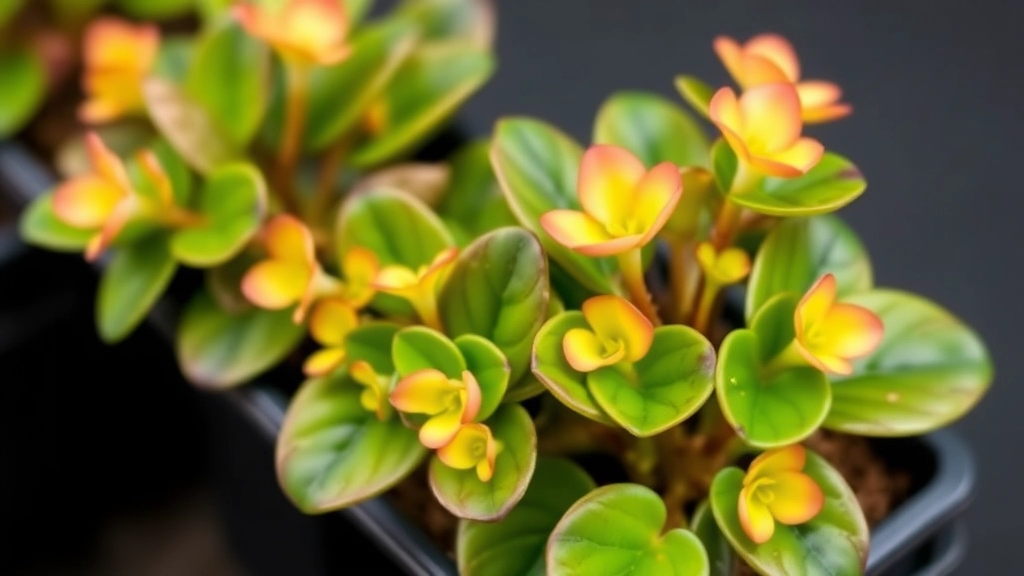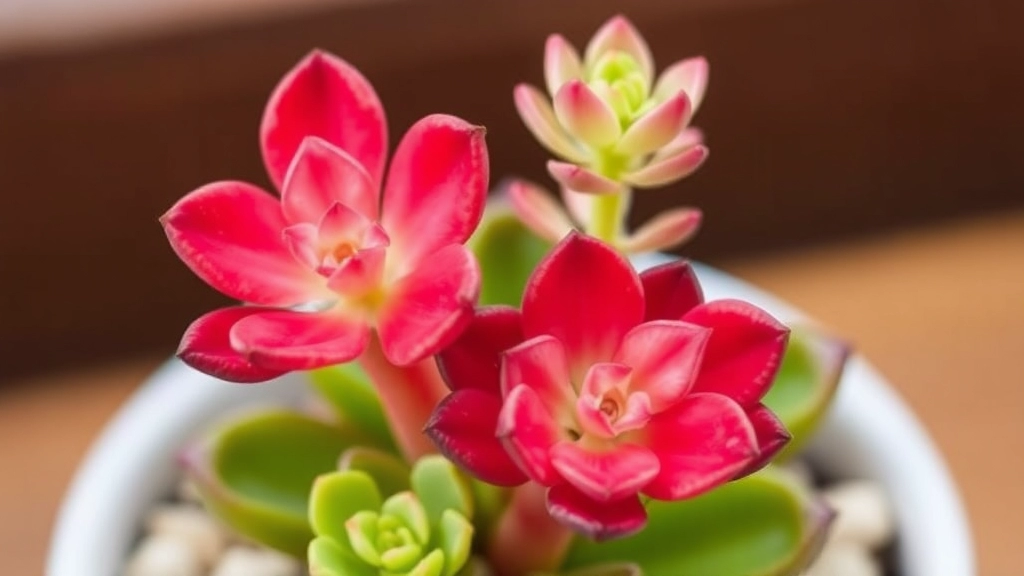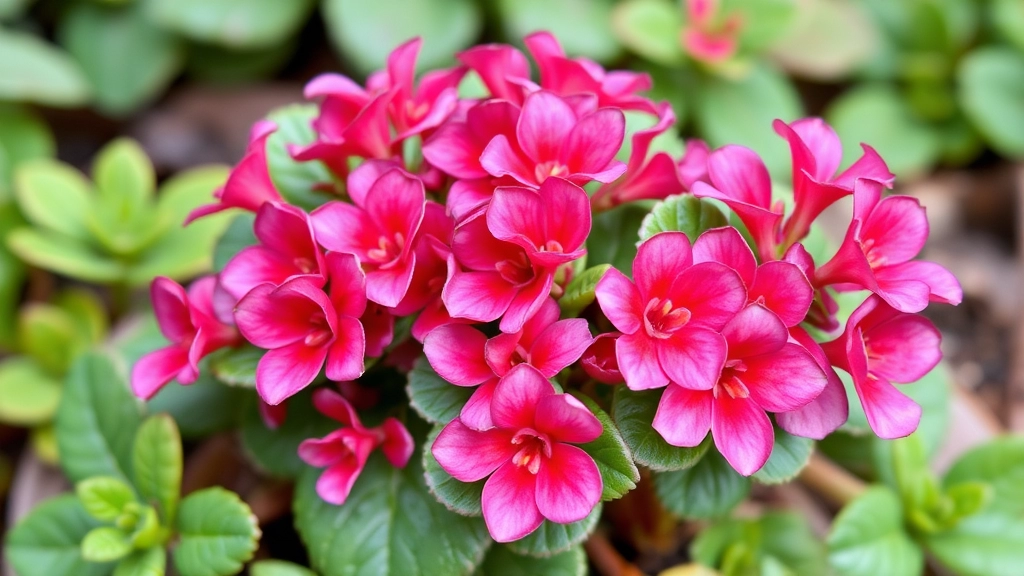Small Leaf Kalanchoe
Small Leaf Kalanchoe is a charming succulent that brings a touch of greenery to any space with minimal fuss. These petite plants are perfect for small gardens or indoor settings, offering a unique aesthetic with their compact, vibrant foliage. Understanding their distinct characteristics can help you provide the best care and enjoy their beauty year-round.
Growing Small Leaf Kalanchoes
When it comes to growing Small Leaf Kalanchoes, they thrive in well-draining soil and need moderate watering. Ensure they get plenty of indirect sunlight and maintain a warm environment to keep them healthy. These succulents are also easy to propagate, making them a favourite among plant enthusiasts looking to expand their collection.
Benefits of Small Leaf Kalanchoes
- Easy to Care For: Suitable for both seasoned gardeners and beginners.
- Visually Appealing: Adds a unique aesthetic to any space.
- Propagation: Simple to propagate for expanding your collection.
Characteristics of Small-Leaf Kalanchoe Varieties
Are you curious about what makes small-leaf Kalanchoe varieties stand out? These delightful succulents bring a unique charm to any space, and understanding their characteristics is essential for any plant enthusiast.
Small-leaf Kalanchoes are known for their compact size and dense foliage.
- Leaf Structure: The leaves are typically small, thick, and fleshy, which helps them retain water. This adaptation is crucial for survival in arid environments.
- Variety of Colours: You’ll find a spectrum of colours, from deep greens to vibrant reds and purples, adding visual interest to your collection.
- Growth Habit: These plants usually have a bushy growth pattern, making them ideal for indoor pots or small garden spaces.
- Flowering: Many small-leaf Kalanchoes produce clusters of colourful flowers. These blooms can last for weeks, adding a pop of colour to your home.
- Drought Tolerance: Their ability to thrive on minimal water makes them perfect for busy individuals or those new to gardening.
In summary, the small-leaf Kalanchoe varieties are compact, colourful, and low-maintenance, making them a favourite among succulent lovers. For more details on how to care for these plants, check out our complete guide on caring for Kalanchoe succulents. Additionally, if you’re interested in propagation techniques, our step-by-step guide on Kalanchoe propagation is a must-read.
Ideal Growing Conditions for Small-Leaf Kalanchoes

So, you’ve got your eye on small-leaf kalanchoes, and you’re wondering what their ideal growing conditions are, right? You’re not alone! Many plant lovers want to ensure their succulents thrive. Let’s dive into what makes these little beauties happy.
Light Requirements
Small-leaf kalanchoes love bright, indirect sunlight.
- Location: A south or west-facing window is perfect.
- Duration: Aim for about 6 hours of light each day.
- Signs of Too Much Sun: If the leaves start to brown or look crispy, they might be getting scorched.
Temperature and Humidity
These plants are pretty chill when it comes to temperature.
- Ideal Range: They prefer temperatures between 18°C to 24°C.
- Cold Sensitivity: Avoid exposing them to frost; they’re not fans of the cold!
- Humidity: They thrive in low humidity, so don’t worry if your home is a bit dry.
Placement
Finding the right spot in your home can make all the difference.
- Indoor: Keep them on a shelf or table where they can soak up the light.
- Outdoor: If you’re placing them outside, ensure they’re sheltered from harsh afternoon sun.
Watering and Soil Requirements for Healthy Growth
When caring for small-leaf kalanchoes, one of the most pressing concerns is ensuring they receive the right amount of water and the ideal soil mix. This is essential for their overall health and vitality.
Propagation Methods for Small-Leaf Kalanchoe Succulents

When it comes to expanding your collection of small-leaf Kalanchoe succulents, knowing the best propagation methods can make all the difference. Many plant enthusiasts often wonder how to effectively propagate these resilient plants.
Leaf Cuttings
One of the most common and straightforward methods is through leaf cuttings. Here’s how to do it:
- Select a Healthy Leaf: Choose a mature leaf from a healthy plant.
- Cut the Leaf: Use a clean, sharp knife to make a clean cut.
- Let it Callous: Place the leaf in a dry area for a few days until the cut edge forms a callous.
- Plant the Leaf: Once calloused, place the leaf on well-draining soil, lightly pressing it down.
- Water Sparingly: Mist the soil lightly, ensuring it remains slightly moist but not soggy.
Offsets
Another effective method is using offsets, or “pups,” that grow around the base of the parent plant:
- Identify Offsets: Look for small plants that emerge from the base.
- Gently Remove: Carefully separate the offset from the parent plant, ensuring it has some roots.
- Replant: Place the offset in a separate pot with appropriate soil.
- Water Appropriately: Water lightly until established.
Seed Propagation
While less common, seed propagation is also possible:
- Collect Seeds: If your Kalanchoe flowers, you can collect the seeds once they mature.
- Prepare Soil: Use a seed-starting mix for best results.
- Sow Seeds: Scatter seeds on the surface and lightly cover them with soil.
- Maintain Moisture: Keep the soil consistently moist until germination.
These methods not only allow you to grow more plants but also provide a rewarding experience as you nurture new life.
Common Issues and How to Avoid Them
When caring for small-leaf Kalanchoes, it’s natural to encounter some challenges.
What are the most common problems you might face?
- Overwatering
Symptoms: Yellowing leaves, wilting, and root rot.
Solution: Allow the soil to dry completely between waterings. Use well-draining soil to prevent water accumulation. For more detailed advice, check out our guide on why Kalanchoe flowers might be dying. - Underwatering
Symptoms: Droopy leaves and shrivelling.
Solution: Water thoroughly when the top inch of soil feels dry. - Insufficient Light
Symptoms: Leggy growth and pale leaves.
Solution: Place your Kalanchoe in a bright spot, ideally where it can receive indirect sunlight for several hours daily. Learn more about optimal lighting in our article on Kalanchoe flower meaning in Japanese culture. - Pests
Symptoms: Visible insects, sticky residue, or webbing.
Solution: Regularly inspect your plants. If pests are spotted, treat them with insecticidal soap or neem oil. - Temperature Fluctuations
Symptoms: Leaf drop or browning.
Solution: Keep your Kalanchoe in a stable environment, ideally between 15°C and 25°C. Avoid drafts and sudden temperature changes.
By being proactive and attentive to these common issues, you can ensure your small-leaf Kalanchoes thrive.
Decorative Uses and Placement for Small-Leaf Kalanchoes
So, you’ve got your small-leaf Kalanchoes thriving, and now you’re wondering how to show them off.
These charming succulents aren’t just easy to care for; they also bring a unique touch to your space.
Where to Place Your Kalanchoes
- Windowsills
These plants love light, so a sunny windowsill is perfect. They’ll soak up the sun and add a pop of colour to your home. - Shelves and Bookcases
Kalanchoes can fit snugly on shelves, bringing life to your bookshelves. Mix them with books and other decor for a stylish look. - Dining Tables
A small Kalanchoe can be a lovely centrepiece. Pair it with a beautiful pot, and it becomes an instant conversation starter. - Office Desks
Need a little cheer at work? A small-leaf Kalanchoe can brighten up your desk and boost your mood.
Creative Display Ideas
- Terrariums: Create a mini desert landscape.
- Hanging Planters: Perfect for small spaces; they add vertical interest.
- Group Arrangements: Mix different varieties together for a lush look.
Tips for Styling
- Choose pots that complement your decor style.
- Use contrasting colours to make your Kalanchoes pop.
- Remember to rotate them occasionally for even growth and light exposure.
FAQs on Small-Leaf Kalanchoe
What are the ideal light conditions for Small-Leaf Kalanchoe?
Small-Leaf Kalanchoe plants thrive in bright, indirect sunlight. A south or west-facing window is ideal, and they need about 6 hours of light each day. If the leaves start to brown or look crispy, they might be getting too much sun.
What temperature range is best for Small-Leaf Kalanchoe?
The ideal temperature range for Small-Leaf Kalanchoe is between 18°C to 24°C. They should be protected from frost and cold temperatures.
How does humidity affect Small-Leaf Kalanchoe?
Small-Leaf Kalanchoe plants thrive in low humidity environments, so they are well-suited for homes that are a bit dry.
Where is the best place to keep Small-Leaf Kalanchoe indoors?
Indoors, Small-Leaf Kalanchoe should be placed on a shelf or table where they can receive adequate light. Ensure they are not exposed to harsh afternoon sun if placed outdoors.
How can I propagate Small-Leaf Kalanchoe using leaf cuttings?
To propagate using leaf cuttings:
- Select a mature, healthy leaf.
- Cut the leaf with a clean, sharp knife.
- Let the cut edge callous for a few days.
- Place the leaf on well-draining soil and press lightly.
- Mist the soil lightly to keep it slightly moist.
What are offsets and how do I use them for propagation?
Offsets, or “pups,” are small plants that grow around the base of the parent plant. To propagate using offsets:
- Identify and gently remove the offsets from the parent plant, ensuring they have some roots.
- Replant the offset in a separate pot with appropriate soil.
- Water lightly until the offset is established.
Can I propagate Small-Leaf Kalanchoe from seeds?
Yes, seed propagation is possible but less common. To propagate from seeds:
- Collect seeds from mature flowers.
- Use a seed-starting mix and scatter the seeds on the surface, lightly covering them with soil.
- Keep the soil consistently moist until germination.
References
-
The Spruce: Growing Kalanchoe Indoors
-
Gardening Know How: Kalanchoe Care â How To Grow Kalanchoe Plants
-
House Plants Expert: Kalanchoe Succulent
